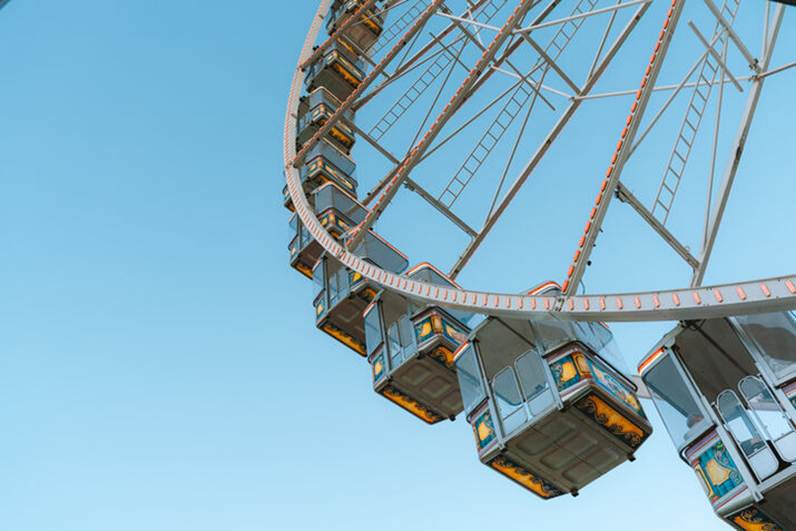
Ferris Wheel Accidents: Liability Explained
When a Classic Ride Suddenly Feels Unsafe
Ferris wheels are supposed to be calm. A slow lift, a wide view, a deep breath. You step into the gondola trusting the bolts, the controls, and the people running the panel.
When something jerks, stalls, or snaps, that easy moment vanishes and you’re left scared, hurting, and looking for answers that should’ve existed before the wheel ever turned.
At Horn Wright, LLP, our personal injury attorneys handle Ferris wheel and amusement-ride injury claims across New York and also serve clients in New Jersey, New Hampshire, Vermont, and Maine.
The rules shift across those borders, so your legal strategy has to match the venue. If a Ferris wheel incident left you or your child injured, contact our team at (855) 465-4622. We’ll move quickly to secure evidence, steady the process, and make sure the park—and anyone else involved—doesn’t control the narrative.

Why Ferris Wheel Accidents Happen
A ferris wheel may look simple, but it’s a tall, moving structure packed with parts that need care. When inspections slip or operators rush, small problems turn into big failures.
- Mechanical wear that no one addressed: Bearings, axles, and fasteners fatigue under daily loads. If torque checks and component replacements get “stretched,” parts loosen and cabins tilt or bind. A responsible park follows the manufacturer’s maintenance schedule, logs work with real numbers—not just signatures—and benches the ride at the first red flag. When that diligence is missing, risk rolls straight into the queue.
- Operator errors at the panel: Boarding, latching, and speed control depend on focused attendants. A missed restraint, an ignored vibration, or a decision to keep running through alarms can set the stage for injuries. Proper training and supervision prevent this. When the booth treats warnings like background noise, you pay for their shortcuts.
- Weather and wind pushed too far: Ferris wheels are vulnerable to gusts and lightning. Parks should monitor wind speeds and shut down before cabins start to sway dangerously. Pushing through “just one more cycle” invites trouble at height. Sensible weather protocols aren’t optional; they’re safety 101.
- Assembly mistakes at traveling setups: Portable wheels at fairs are broken down and rebuilt on tight timelines. Skip a torque sequence, misalign a section, or reuse hardware past its life, and you’ve created a weak point. Competent crews document every step. Thin records usually mean thin assembly.
Crowds don’t cause these events. Choices do. And choices leave paper trails we know how to read.
Injuries You Might be Facing after a Ferris Wheel Incident
Impacts and awkward positions at height create a unique set of injuries. You’re not braced for them, which makes recovery tougher than you’d expect.
- Head and neck trauma that lingers: A sudden jolt inside the gondola can cause whiplash and concussions. Headaches, dizziness, and light sensitivity often show up hours later and stick around. Early imaging and consistent follow-ups help you heal and protect the link between the ride and your symptoms.
- Spinal injuries that change routines: Compressed vertebrae, herniated discs, and nerve pain can follow abrupt stops or cabin misalignment. Sitting, sleeping, and lifting all get complicated. Treatment plans—therapy, injections, sometimes surgery—belong in your damages, not your personal budget.
- Fractures and shoulder damage from instinctive bracing: Most people throw their arms up when they’re scared. That’s how wrists, elbows, and shoulders take the hit. Fractures and rotator-cuff tears limit what you can lift or reach, and that limit affects both work and home life.
- Emotional fallout that’s easy to overlook: Panic in crowds, fear of heights, trouble sleeping—it’s all part of the picture. Kids, especially, can struggle with confidence after a scary ride event. These aren’t minor issues; they’re real losses the law allows you to claim.
Your life doesn’t pause for recovery. A complete case accounts for the physical, financial, and emotional impact—today and down the road.
Who Can be Held Responsible And Why
Liability rarely stops with one person in a booth.
In New York, owners and operators owe you a reasonably safe experience. That means trained staff, working safety devices, and maintenance that matches manufacturer specs. If those basics fail, the park is squarely in the frame.
Responsibility often extends outward. Maintenance contractors can share fault when inspection or repair work misses obvious defects. Manufacturers face exposure when defective components or confusing control layouts make safe operation harder than it should be.
With traveling wheels, assembly crews must follow torque sequences and alignment procedures exactly; sloppy work becomes shared liability.
Our job, as your amusement park accident attorneys, is to trace the failure back through records—work orders, part numbers, staffing rosters, weather logs—and show how each decision lined up with what happened to you. When the chain of cause is clear, accountability follows it.
How New York Law Approaches Ferris Wheel Liability
New York applies familiar, but powerful, rules to amusement-ride injuries.
Negligence is the backbone: if the park didn’t act like a reasonably careful operator (skipping checks, ignoring warnings, running in unsafe wind), that’s a breach of duty.
Premises liability adds the obligation to find hazards they know about, or should find with regular inspection, and fix or clearly warn about them. New York also uses comparative negligence. Even if the defense claims you were distracted, you can still recover; any award is just reduced by your percentage of fault.
Cross the river and the math changes. New Jersey can cut off recovery if you’re found more than 50% at fault, while Vermont and New Hampshire reduce damages by percentages and Maine often expects tighter negligence proof. Venue matters, so we tailor the strategy to where your claim will land.
One more note: liability waivers aren’t a blank check. They don’t excuse a park from maintaining safe equipment or following basic standards. We’ll evaluate any paperwork and keep the focus on what actually failed.
What to Do Right Away (Simple Steps that Help a Lot)
The hours after an incident are chaotic. A few steady moves protect your health and your claim.
- Get medical care the same day: Go to the emergency room or urgent care even if you “feel okay.” Concussion and internal injuries can hide for hours. Tell providers exactly what happened, where you were seated, and what moved or failed. Those details guide treatment and lock in causation for your file.
- Report it in writing and keep a copy: Ask the park to file an incident report, then photograph or request a copy. Include time, location, ride name, cabin number, and what the operator did (or didn’t) do. Early, specific details keep the story from shifting later.
- Document the scene: Take photos or short video of the wheel, your cabin, and any visible issues—missing hardware, swaying in wind, stalled cabins. Capture signage and crowd conditions, too. If something looks off, it probably is, and images beat memory.
- Collect witness info: Other riders or bystanders may have noticed a noise, a vibration, or wind warnings. Names and numbers now are worth more than fuzzy recollections later. Quick voice notes on your phone help you keep details straight.
Once we’re on board, we’ll send preservation demands for surveillance video, work orders, inspection logs, and weather data so crucial proof doesn’t “update” away.
The Real Costs You shouldn’t Have to Carry
It’s never just the emergency room bill. It’s missed shifts, lost overtime, childcare shuffles, and appointments that steal evenings. If your work needs lifting, climbing, or steady focus, limits hit your paycheck fast. That gap between rising costs and shrinking income gets heavy and shouldn’t be yours alone.
There’s a quieter cost, too. You scan overhead fixtures now. Crowds feel different. A simple night out takes planning instead of ease. Kids may hesitate near rides, struggle with sleep, or avoid noise altogether. These are real consequences, and they belong in the numbers.
A fair resolution accounts for medical care today and tomorrow, therapy, travel for treatment, lost income, reduced earning capacity, and the personal impact on your day-to-day life. When the claim reflects real life, negotiations start making sense.
How We Build a Winning Ferris Wheel Case
Good cases are detailed. We compare inspection schedules with what actually happened, match part numbers to service bulletins, and line up staffing charts against the shift in the booth. If the wheel is portable, we review assembly checklists and torque records. If weather was a factor, we pull data, alarms, and park protocols.
Experts make the technical clear. Engineers explain why the failure happened and how it should’ve been prevented. Doctors connect forces to injuries and forecast future care. Economists translate missed work and long-term limits into numbers insurers can’t shrug off. When the file reads trial-ready, carriers negotiate differently. Preparation is leverage.
You get transparency from us the whole way—what we’re doing, why it matters, and what comes next.
Bringing Clarity and Accountability to Ferris Wheel Accidents
You climbed aboard for a calm, shared moment, not a cascade of pain and paperwork. That promise of safety should hold in New York and wherever you ride—New Jersey, New Hampshire, Vermont, or Maine.
When it doesn’t, our job is to make the record clear, push for change, and secure the resources you need to feel steady again. A ferris wheel should lift you up every time. If negligence brought you down, we’ll lift the burden, press for accountability, and help you look out over the city with confidence again.
Contact our office today to arrange your complimentary consultation.

What Sets Us Apart From The Rest?
Horn Wright, LLP is here to help you get the results you need with a team you can trust.
-
Client-Focused ApproachWe’re a client-centered, results-oriented firm. When you work with us, you can have confidence we’ll put your best interests at the forefront of your case – it’s that simple.
-
Creative & Innovative Solutions
No two cases are the same, and neither are their solutions. Our attorneys provide creative points of view to yield exemplary results.
-
Experienced Attorneys
We have a team of trusted and respected attorneys to ensure your case is matched with the best attorney possible.
-
Driven By Justice
The core of our legal practice is our commitment to obtaining justice for those who have been wronged and need a powerful voice.

